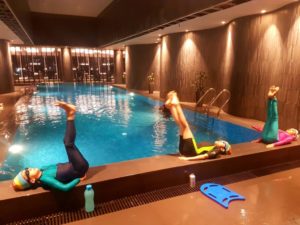Dryland Training Tips for the Active Swimmer
September 23, 2022 / Athletic Leader • Player Safety • Strength & Conditioning • Strength & Conditioning
When training to become a top-flight swimmer, it’s equally as important to train on the land as it is to train in the pool.
A recent story from Swimming World Magazine gave a few dryland training tips to see gains in the pool.
Below is an excerpt from the Swimming World Magazine story.- Running — Arguably the best sport a swimmer can do in terms of developing stellar fitness is running. It isn’t uncommon for runners to be good swimmers because they have great overall conditioning, which allows them to train long and hard in the pool.
 In addition, as any runner can tell you, running can be very mentally draining, which can help with the mental component of swimming as well. In addition to conditioning, running can develop highly efficient muscles that are needed for swimming.
In addition, as any runner can tell you, running can be very mentally draining, which can help with the mental component of swimming as well. In addition to conditioning, running can develop highly efficient muscles that are needed for swimming. - Flexibility Work — Doing five minutes of flexibility work a couple of times every day is another habit that can go a long way for swimmers. Using a foam roller is a great way to ease any soreness you have. Static stretching can also be helpful for the improvement of your range of motion. The cool thing about flexibility work is that it isn’t time-consuming.Doing it at night before you go to bed and when you wake up is a great habit to get into, but even if you just start doing it a little bit, your body will thank you.
- Core Work — Core work helps swimmers to maintain optimal posture and balance in the water. If you increase your core’s stability, it will keep your body’s resistance at a minimum while keeping a higher body position. A solid bodyline will keep you positioned high in the water as you start to fatigue, and yield a large gain in overall swimming performance.
- Recovery — Among the most essential components of an optimal swim season is giving your body the rest it needs. Whether it’s cooling down after a brutal practice, or just getting that extra hour of sleep, recovery will allow your body to perform at its best day in and day out. The best part? It requires very little work! Although it’s perhaps difficult to make recovery a habit if it isn’t already, your body will thank you and you’ll feel the difference over time.
At the end of the day, the work you put into your training is only going to be as good as your recovery.
To read the full story from Swimming World Magazine about dryland training techniques to boost performance in the pool, click here.







